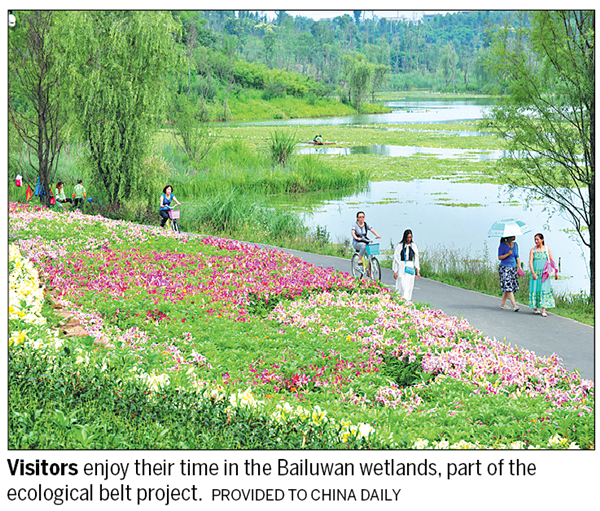Ecological city projects aim to improve lifestyles, lower emissions

Chengdu, an attractive city in Southwest China, is on its way to becoming a low-carbon region.
The city government has prioritized an ecological belt project in recent years in order to promote its urban environment. The project, due to be completed in 2020, will cover an area of 133.11 square kilometers and will include areas flanked by the city's ring expressway.
Reservoirs and wetlands are key parts of the plan, with the construction of three reservoirs and six wetland areas expected to wrap up this year.
Chengdu has implemented protection regulations for the ecological belt, making itself the first city in China to release local regulations for such protection in specific areas of a city.
The ecological belt, on which construction started in 2012, has so far received more than 10 million visitors annually. Tourists have also given favorable comments on the beautiful environment and free access to the belt, Chengdu Daily reported.
The city recently issued a pilot implementation plan to build a low-carbon city, which outlines how Chengdu will promote this development in three phases.
The city aims to make its total carbon emissions peak before 2025 and become an advanced city domestically in terms of low-carbon development.
According to the plan, energy efficiency in Chengdu will remarkably increase by the end of 2020 and the carbon emission levels of the city's main industries will approach or be among the lowest globally. Total greenhouse gas emissions in Chengdu will also be reasonably controlled by then, according to the plans.
Local officials said market mechanisms to help save energy and reduce carbon emissions will be established at that time.
They added that Chengdu hopes to become a role model in western China in terms of low-carbon production and a green lifestyle.
The city government has put forward detailed goals to ensure the plans are implemented, aiming for consumption of non-fossil fuel energy to account for 30.3 percent of primary energy consumption. The administration aims to achieve forest coverage of 40 percent and central urban greenery coverage of 45 percent.
The Sino-French Ecological Park in the Chengdu Economic and Technological Development Zone will be an exemplary low-carbon area in Chengdu that will explore a new city construction path that integrates both the city's and industries' development in terms of low energy consumption and low carbon emissions.
The park is focusing on strategic emerging industries such as energy-saving and environmental protection, new energies, new materials and advanced equipment manufacturing. A representative from the park said their design concept is to bring nature into the city so that the park will be an attractive area with a pleasing environment.
Chengdu has embraced two innovative approaches to improve its environment.
One of them is to encourage enterprises and the public to participate in greenhouse gas emissions reduction, and to guide residents to have more environmentally-friendly and healthy lifestyles, including consumption habits.
In addition, the city government aims to explore and set up a traceability system to ensure the city's total carbon emissions will peak before 2025 as planned.
The system will be based on a data management platform.








